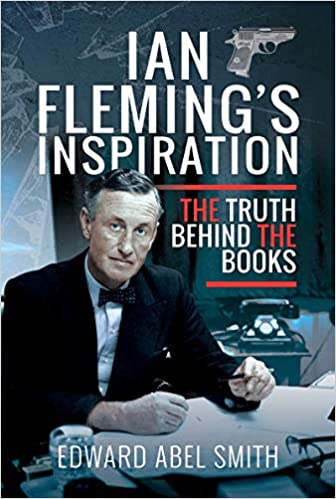
Ian Fleming’s Inspiration. The Truth Behind the Books. By Edward Abel Smith. Pen & Sword History, Barnsley, 2021. ISBN 978-1-52679-198-6
Reviewed by David Hobbs
Edward Abel Smith is a British writer who studied Sociology and Anthropology at Oxford Brooks University. His first book was published in 2017 and described how thousands of Jews were rescued from the Nazis by Trevor Chadwick, Doreen Warriner and Nicholas Winton. He has been commissioned by Pen & Sword to write further books on similar subjects.
The publication of Ian Fleming’s Inspiration was timed to coincide with the belated release of the latest James Bond film,a fact highlighted on its paperback cover with the statement ‘Find out how much of Fleming’s Bond appears in No Time to Die’. Potential readers should be aware that it was never intended to cover the role of intelligence within the naval staff during World War Two in any great depth. The author’s understanding of the relationship between the Naval Intelligence Division, SOE and the Joint Intelligence Committee is somewhat limited and those who want a more detailed study of this complex subject would find Andrew Boyd’s British Naval Intelligence through the Twentieth Century to be a more detailed and analytical source of information. There are a few minor mistakes; for instance the dead body of Glyndwr Michael dropped off Huelva in Spain in Operation Mincemeat, one of the war’s most successful deception plans, was dressed as a Royal Marines officer, not as a naval officer as stated on page 25.
These points aside, this book does succeed as a short and simple biography of Ian Fleming which draws readers’ attention to events that stimulated the creation of the plots, villains and locations in his novels and short stories about James Bond. This is where the book’s strength lies. It is divided into two sections, the first of which covers the Second World War during which Fleming was a Commander RNVR serving as Personal Assistant to the Director of Naval Intelligence. He was, thus, at the centre of naval intelligence policy, planning and organisation besides being a key player in the wider Whitehall intelligence community. The second section covers the years after 1945 with the focus on Goldeneye, Fleming’s house on the shore of Jamaica in which he wrote the novels that were to become world famous. The depth into which the author goes when describing real events varies depending on the extent to which he feels that they influenced Fleming as he sat at his typewriter and began to describe Bond and his fictional missions. However, the book does have a bibliography and source notes so that readers who want to delve further can find out where Abel Smith gathered his information.
The book is written in a style which is easy to read, making it an informative companion for any fan of the James Bond stories who wants to know more about how they evolved. For instance, Fleming’s original choice of name for his hero was Peregrine Maltravers. I was interested by the descriptions of Fleming’s wartime visits to the USA and the extent to which they are reflected in the Bond stories. This is a book that can be picked up and read for short periods; on a journey perhaps. Overall it gave me a better understanding of the genre which I must admit to not having known previously in any great detail, I enjoyed reading it and if you want to know more about how James Bond evolved or his creator’s remarkable life style I recommend it.



